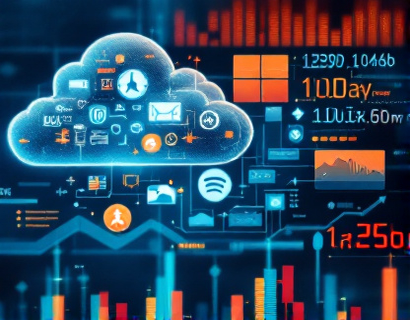Data-Driven Social Marketing: Transforming Business Engagement with Advanced Online Strategies
In the rapidly evolving digital landscape, businesses are constantly seeking innovative ways to enhance their online presence and engage with their audience effectively. One of the most powerful tools at their disposal is data-driven social marketing. This approach leverages advanced analytics and strategic insights to optimize content, streamline management, and maximize digital engagement. This comprehensive guide delves into the key strategies and techniques that businesses can employ to transform their social marketing efforts, ensuring they remain competitive and relevant in the digital age.
Understanding Data-Driven Social Marketing
Data-driven social marketing is a strategic approach that utilizes data analytics to inform and optimize social media activities. Unlike traditional social marketing, which often relies on intuition and guesswork, data-driven strategies are grounded in empirical evidence and measurable insights. This method involves collecting and analyzing data from various sources, including social media platforms, customer feedback, and market trends, to make informed decisions.
The primary goal of data-driven social marketing is to enhance audience interaction, improve content relevance, and increase overall engagement. By understanding what resonates with the target audience, businesses can tailor their content and strategies to better meet their needs and preferences. This not only fosters stronger relationships but also drives higher conversion rates and brand loyalty.
Key Components of Data-Driven Social Marketing
To implement a successful data-driven social marketing strategy, businesses must focus on several key components. These include audience analysis, content optimization, performance tracking, and continuous improvement.
Audience Analysis
Understanding the target audience is the foundation of any effective marketing strategy. Data-driven social marketing begins with comprehensive audience analysis, which involves gathering and analyzing demographic, psychographic, and behavioral data. This data can be sourced from social media analytics tools, customer surveys, and market research reports.
Key metrics to consider include age, gender, location, interests, and online behavior. By segmenting the audience into distinct groups, businesses can create more personalized and relevant content. For instance, a fashion brand might identify that a specific age group is more active on Instagram and tailor its content accordingly.
Content Optimization
Once the audience is well-defined, the next step is to optimize content for maximum impact. Data-driven content optimization involves creating and distributing content that aligns with the audience's preferences and behaviors. This includes selecting the right content formats, topics, and posting times.
Content formats such as videos, images, and infographics can be analyzed to determine which types perform best. For example, if data shows that video content receives higher engagement, the business should allocate more resources to video production. Additionally, A/B testing different content variations can help identify the most effective elements.
Posting times are another critical factor. By analyzing when the audience is most active, businesses can schedule posts to maximize visibility and engagement. Tools like social media analytics provide insights into peak activity periods, allowing for strategic timing of content releases.
Performance Tracking
Tracking the performance of social marketing efforts is essential for measuring success and making data-driven decisions. Performance tracking involves monitoring key performance indicators (KPIs) such as engagement rates, reach, click-through rates, and conversion rates. These metrics provide valuable insights into the effectiveness of different strategies and content types.
Social media analytics tools offer detailed reports and dashboards that make it easy to track these KPIs in real-time. By regularly reviewing performance data, businesses can identify trends, successes, and areas for improvement. For instance, if a particular campaign fails to meet expectations, analyzing the data can reveal why and inform future strategies.
Continuous Improvement
Data-driven social marketing is not a one-time effort but an ongoing process of learning and adaptation. Continuous improvement involves regularly refining strategies based on new data and insights. This iterative approach ensures that the business stays ahead of the curve and continues to engage its audience effectively.
One effective method for continuous improvement is the use of feedback loops. By collecting and analyzing customer feedback, businesses can gain deeper insights into audience preferences and pain points. This feedback can then be used to adjust content and strategies, creating a virtuous cycle of improvement.
Advanced Strategies for Enhanced Engagement
To truly excel in the digital landscape, businesses must adopt advanced strategies that go beyond basic social media management. Here are some sophisticated techniques to enhance audience interaction and optimize content distribution.
Personalization at Scale
Personalization is a powerful tool for increasing engagement, but achieving it at scale requires advanced data analytics and automation. By leveraging machine learning algorithms, businesses can create highly personalized content and experiences for each audience member.
For example, dynamic content can be used to customize the user interface based on individual preferences and behaviors. This might include personalized product recommendations, tailored messaging, and customized visuals. Such personalization not only enhances user experience but also increases the likelihood of conversion.
Predictive Analytics
Predictive analytics involves using historical data to forecast future trends and behaviors. In the context of social marketing, predictive analytics can help businesses anticipate audience needs and preferences, allowing for proactive content creation and distribution.
By analyzing patterns in user behavior, businesses can identify which types of content are likely to perform well in the future. For instance, if data shows that posts about sustainability resonate strongly with the audience, the business can create more content around this theme. Predictive analytics can also help optimize posting times and channels, ensuring that content reaches the audience when they are most receptive.
Influencer Collaboration
Influencer marketing remains a potent strategy in the digital age, and when combined with data-driven insights, it can be even more effective. By partnering with influencers who align with the brand's values and resonate with the target audience, businesses can expand their reach and credibility.
Data can help identify the most influential and relevant influencers for a specific campaign. Metrics such as follower engagement rates, content quality, and audience demographics provide valuable insights. Additionally, tracking the performance of influencer collaborations through unique promo codes or tracking links can help measure ROI and inform future partnerships.
Social Listening
Social listening involves monitoring online conversations to gain insights into customer sentiment, trends, and emerging issues. This proactive approach allows businesses to stay informed and respond promptly to audience concerns and feedback.
Advanced social listening tools can track mentions of the brand, competitors, and industry-related topics across multiple platforms. By analyzing the sentiment and context of these conversations, businesses can identify opportunities to engage with the audience, address issues, and showcase their expertise. This not only enhances brand reputation but also builds trust and loyalty.
Optimizing Content Distribution
Effective content distribution is crucial for maximizing reach and engagement. Data-driven strategies can help businesses optimize their content distribution channels and timing to achieve better results.
Channel Optimization
Different social media platforms have unique user demographics and content preferences. Data-driven channel optimization involves analyzing performance metrics to determine which platforms are most effective for reaching and engaging the target audience.
For example, if data shows that a particular product category performs better on Instagram compared to Facebook, the business should focus its efforts on Instagram for that category. Similarly, platforms like LinkedIn may be more suitable for B2B content.
Content Scheduling
Content scheduling tools can significantly enhance distribution efficiency by automating the posting process. These tools allow businesses to plan and schedule posts in advance, ensuring consistent and timely content delivery.
By analyzing data on audience activity and engagement, businesses can optimize the timing of scheduled posts. For instance, if data indicates that the audience is most active in the evening, scheduling posts for that time can increase visibility and interaction.
Cross-Platform Integration
Integrating content across multiple platforms can amplify reach and engagement. Data-driven strategies can help identify opportunities for cross-platform content sharing and collaboration.
For example, a blog post can be repurposed into social media content, such as infographics or short videos, and shared across different platforms. This not only saves time but also ensures a consistent brand message. Additionally, using unique hashtags and calls-to-action can drive traffic and engagement across channels.
Measuring and Analyzing Performance
Measuring the success of social marketing efforts is essential for validating strategies and making data-driven adjustments. Advanced analytics tools provide comprehensive insights into performance metrics, enabling businesses to track progress and optimize their approaches.
Key Performance Indicators
Selecting the right KPIs is crucial for evaluating the effectiveness of social marketing campaigns. Common KPIs include engagement rate, reach, click-through rate, conversion rate, and return on investment (ROI). Each metric offers unique insights into different aspects of campaign performance.
Engagement rate, for instance, measures the level of interaction users have with the content, such as likes, comments, and shares. A high engagement rate indicates that the content resonates with the audience. Reach measures the number of unique users who see the content, while click-through rate tracks the percentage of users who click on links within the content.
Conversion rate is particularly important for businesses with specific actionable goals, such as generating leads or sales. ROI, on the other hand, provides a financial perspective on the campaign's effectiveness, helping to justify the investment in social marketing.
Data-Driven Insights
Advanced analytics tools can provide deep insights into the data, helping businesses understand the underlying factors that drive success or failure. For example, sentiment analysis can reveal how users feel about the brand or specific content pieces, while cohort analysis can track the behavior of user groups over time.
By combining these insights with qualitative feedback, businesses can gain a holistic view of their social marketing performance. This comprehensive understanding enables more informed decision-making and strategic adjustments.
Building a Data-Driven Culture
Implementing data-driven social marketing requires more than just tools and techniques; it also involves fostering a culture of data literacy and analysis within the organization. Here are some steps to build a data-driven culture:
Training and Education
Ensure that team members have the necessary skills and knowledge to work with data. This may involve providing training on data analytics tools, statistical analysis, and data interpretation. Regular workshops and seminars can help keep the team updated on the latest trends and best practices.
Data-Driven Decision-Making
Encourage all levels of the organization to make decisions based on data rather than intuition. This involves setting clear data-driven goals, establishing metrics for success, and regularly reviewing performance data. Leaders should lead by example, demonstrating how data informs their strategic choices.
Collaboration and Communication
Foster collaboration between different departments, such as marketing, sales, and product development, to ensure that data insights are shared and utilized across the organization. Regular cross-functional meetings can help align efforts and leverage data for collective success.
Continuous Learning
Data-driven social marketing is an evolving field, and staying ahead requires continuous learning and adaptation. Encourage a mindset of curiosity and experimentation, where team members are encouraged to test new ideas and learn from both successes and failures.
Stay informed about industry developments by following relevant blogs, attending conferences, and participating in online communities. This ongoing learning helps keep the organization at the forefront of data-driven marketing practices.
Conclusion
Data-driven social marketing represents a transformative approach to business engagement in the digital age. By leveraging advanced analytics and strategic insights, businesses can optimize their online presence, enhance audience interaction, and achieve measurable success. The key components of audience analysis, content optimization, performance tracking, and continuous improvement, combined with advanced strategies like personalization, predictive analytics, and cross-platform integration, form a robust framework for social marketing excellence.
As the digital landscape continues to evolve, embracing a data-driven culture and staying committed to continuous improvement will be essential for long-term success. By adopting these practices, businesses can not only survive but thrive in the competitive world of digital marketing.











































